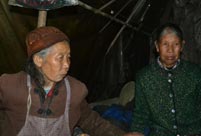

In the evening, many vendors set up stalls in the street. African people, who live in the street or at surroundings, are the main customers of the cheap clothes. (People's Daily Online/Li Dong)
Whether they are in the lounge, in the kitchen or elsewhere in their homes, Africans are now being given a front-row view of how their world, and the world of trade, is changing.
Their guides are the appliances they use to make their lives easier, appliances that used to carry names such as Philips, Samsung and Sanyo, but that now increasingly bear names such as Haier, Hisense and Shinco.
The prevalence of these names is the result not only of the highly competitive prices at which they are sold, but also of an unrelenting drive by Chinese companies to innovate and to localize everything they sell.
In turn, the success of the likes of Haier, Hisense and Shinco in localizing their products for Africa is spurring other Chinese home appliance and electronics companies to make similar efforts, looking to cash in on an increasingly prosperous continent with its growing middle class and lower labor costs.
Broad acceptance across the continent of Chinese appliance brands is still some distance off, but once that process is well under way it will suggest a fundamental shift in sentiment about anything made in China.
What is driving Chinese appliance makers to Africa is not just its undoubted economic promise, but a problem they now face at home: market saturation, which is forcing them to broaden their horizons as they look to keep or increase market share.
More than 45 percent of the refrigerators, washing machines and TVs in the world were made in China, a report by the Development Bank of Singapore in 2013 said. Seventy-five percent of air conditioners and small appliances were made in China, the report said.
China's experience in supplying such goods means its companies have gained expertise in gauging consumer needs. But Africa, a market with widely varying markets from region to region and country to country, presents particular challenges.
Economic growth in sub-Saharan Africa is particularly strong, and the home appliance market is driven by population growth and the rise of the middle class, said Roberto Fogliata, a home appliances specialist responsible for sub-Saharan Africa for the international market research company GfK.
Standard Bank of South Africa said last year that the middle class in Africa had grown substantially over the past 14 years.
In a report titled Understanding Africa's Middle Class, it said there were 15 million middle class households in 11 of sub-Saharan Africa's top economies last year, 230 percent higher than in 1990. The GDP of those economies combined had grown tenfold since 2000, it said.
Thomas Verryn, research manager, sub-Saharan Africa, for the London-based market research company Euromonitor International, says: "Significant growth is expected in the coming years for sub-Saharan Africa. The sub-continent shows strong GDP growth, with an increased demand for both consumer electronics and appliances. Increased urbanization will also drive growth."
Last year, China exported 74.05 million TVs, 24.3 percent more than in 2013, and the value of sales was $13.55 billion, 22.6 percent more than in 2013.
About 23 million fridges were exported, 9.5 percent more than in 2013.
One thing standing in the way of such exports to Africa is high customs duties in many countries, and this is prompting companies to localize manufacturing in the continent.
One of the first Chinese home appliance makers to enter the African market was Haier, in Nigeria in 2001. It has also been in Tunisia since 2012.
 |
 J-11 fighters in air exercise
J-11 fighters in air exercise Beauties dancing on the rings
Beauties dancing on the rings Attendants-to-be join Mr. & Miss Campus Contest
Attendants-to-be join Mr. & Miss Campus Contest Beijing's toughest anti-smoking law takes effect
Beijing's toughest anti-smoking law takes effect Family lives in cave for about 50 years in SW China
Family lives in cave for about 50 years in SW China PLA soldiers operating vehicle-mounted guns in drill
PLA soldiers operating vehicle-mounted guns in drill Blind carpenter in E China's Jiangxi
Blind carpenter in E China's Jiangxi China hosts overseas disaster relief exercise for the first time
China hosts overseas disaster relief exercise for the first time 20 pairs of twins who will become flight attendants in Sichuan
20 pairs of twins who will become flight attendants in Sichuan Obama is sowing discontent in S.China Sea
Obama is sowing discontent in S.China Sea Rescuers work through night to reach cruise ship survivors
Rescuers work through night to reach cruise ship survivors Driving through limbo
Driving through limbo Facing down MERS
Facing down MERSDay|Week